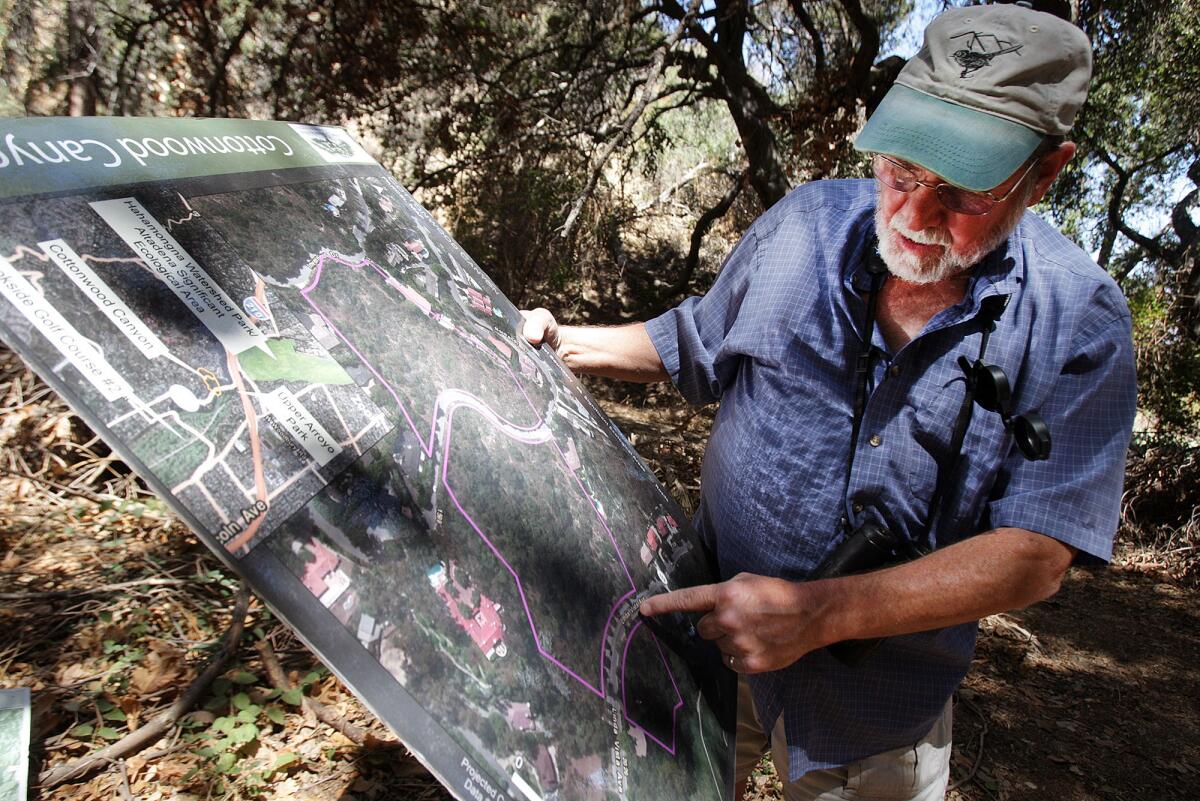Conservancy works to preserve Cottonwood Canyon

On a modest stretch of Linda Vista Avenue near the La Cañada Flintridge-Pasadena border lies a nondescript piece of land whose dry shrubs and trees thinly veil a rich biodiversity of life teeming within.
An old wire fence, laid years ago with a small gap in between posts for occasional passage, offers one entrance into the Cottonwood Canyon, an 11-acre parcel of land that connects the Arroyo Seco, just south of Devil’s Gate Dam, to the San Rafael mountains.
Held jointly for more than a century by two families now looking to sell, the land doesn’t appear to be anything extraordinary. But biologists and land preservationists beg to differ — the parcel contains a natural, year-round spring that attracts wildlife and helps feed multiple floral habitats.
PHOTOS: Conservancy looks to acquire canyon, preserve wildlife corridor
Moreover, it is one of just a few small parcels that connect up with larger preserved areas where various species of animals are still free to live and move about. Left undeveloped, it could continue to serve as an important wildlife corridor connecting the San Rafael, San Gabriel and Verdugo mountains.
For that, and for its biodiversity, the lot is being keenly eyed by the Arroyos & Foothills Conservancy, an Altadena-based group that has worked urgently since 2000 to acquire and preserve open space in and around the San Gabriel and Crescenta valleys.
“It’s the only connection to the Arroyo Seco that we found, said John Howell, chief executive and general counsel for the conservancy. “It’s a wildlife corridor with water on it.”
The conservancy is working with representatives from the landowning families to purchase the territory for $1.3 million, largely through federal grants, and is seeking civic support and engagement, Howell said.
Additionally, the group has set a $300,000 community fundraising goal for the land to create a Friends of Cottonwood volunteer advisory group to foster the territory, plan future community and/or school programs and be involved in restoration.
Currently, La Cañada resident Gordon Crawford has pledged to match every dollar raised up to $50,000 Howell said.
In 2012, the conservancy successfully acquired and restored La Crescenta’s 7.75-acre Rosemont Preserve as well 13 acres of Millard Canyon in Altadena.
Now Arroyos & Foothills Conservancy members are strategizing, searching out available parcels in Pasadena, La Cañada, La Crescenta and Glendale where open space could be preserved and wildlife corridors expanded, potentially all the way to the Los Angeles River, to provide respite to development-weary animals.
And they’re looking for conservation-minded civic leaders and residents who will join them.
On Sept. 16, conservancy board members Katie Poole and Tim Martinez spoke at a regular meeting of the La Cañada Flintridge City Council, seeking a resolution affirming the city’s support of the land acquisition project.
“Our purpose for wanting to preserve this canyon is mainly to protect it from development,” Poole told the council. “Help us figure out how La Cañada can draft such a resolution to support this open space.”
At the meeting, council members agreed to consider placing a supportive resolution on a future agenda.
“I would be happy to support and look at a resolution,” Councilwoman Laura Olhasso said.
Support from city councils and citizens’ groups helps the conservancy obtain grant money to purchase land, sometimes at full market value, which is the case for the Cottonwood Canyon parcel. But given the biological richness of the land, Howell says, the only real cost would be losing it to developers.
Mickey Long, a biologist who worked for the Los Angeles County Parks and Recreation for 35 years and now volunteers with the conservancy, recently led the Valley Sun on a guided tour of the canyon, pointing out features of historic and ecological interest along the way.
This area, he explained, is a habitat mosaic, a rare place where chaparral and riparian life coexist alongside coastal sage scrub and southern oak woodland. That plant diversity attracts a diversity of fauna (Long’s last count is well beyond 100) which dwell and move through the canyons.
“To get all this in one 11-acre property is a good thing,” Long said.
Just beyond the Linda Vista Avenue fence, under the tree canopy, the temperature drops at least 10 degrees Fahrenheit, creating a “thermal refuge” for wild animals.
The water in the year-round spring, created when landowners drilled for water in the 1880s to create the now-defunct Cottonwood Canyon water company, is cool and babbles audibly through the canyon. Periodically, long-abandoned water spigots pop their rusty heads up through the canyon floor.
Along a steep canyon wall, Long points out deer ledges leading right to the water source. The area is dotted with abandoned wood rat homes made of sticks and leaves. Once, Long found an owl pellet containing mouse bones on the property. Though the area is only lightly visited by humans it is abundantly inhabited, he says.
“We have over 40 species of birds known in the property so far without doing a survey, just from our visits.” says Long, a lifelong birder who carries binoculars around his neck.
For Poole, a La Cañada resident and longtime hiker, maintaining open spaces should be a priority for Foothills residents.
“If we can have more open space for people, they’ll be reminded of the power they have to preserve (it),” she said. “If you want people to appreciate nature, you have to have something to show them.”
For more on Cottonwood Canyon and the Arroyos & Foothill Conservancy, visit www.arroyosfoothills.squarespace.com or call (626) 796-0782.
